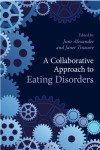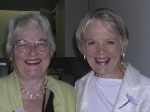Hear this: healing requires a team effort
Hear this: healing requires a team effort
Next week, I depart Australia on a seven-week book research trip to the UK, USA and Canada. The many special people I will meet include Prof. Janet Treasure, Prof. Ivan Eisler, families and sufferers of eating disorders. Every one of us has an important role in finding how to treat eating disorders successfully. One thing we know for sure is that a collaborative approach is essential. This message needs to get out because too many sufferers are continuing to feel misunderstood. Knowledge is power. A Collaborative Approach to Eating Disorders should be on every clinician’s desk. The following review,by Jennifer Thomas, appears in the AED Forum May 2012 edition, p. 8.
A Collaborative Approach to Eating Disorders, edited by June Alexander and Janet Treasure (Routledge, 2012; 316 pages)
“The eating disorder field is necessarily multi-disciplinary — more so than perhaps any other field. Add to this the necessity of a higher degree of family involvement than almost any other field (autism being the closest) and the need for the collaborative approach becomes clear.”
~ Collaborative Approach Preface (p. xvi)
The thesis of the 2012 edited volume A Collaborative Approach to Eating Disorders is that cooperation — between patients and families, carers and treaters, researchers and clinicians — is integral to reducing the burden of suffering from eating disorders. In the spirit of showing rather than telling, the book’s editors facilely model this proposed synergy.
Ms. Alexander herself is a journalist and non-fiction writer who struggled with anorexia and bulimia nervosa for 44 years, detailing her illness and recovery in her memoir A Girl Called Tim: Escape from an Eating Disorder Hell (New Holland Publishers, 2011). Accordingly, each chapter includes memorable journalistic touches such as introductory clinical vignettes and illustrative quotations from patients, carers, and clinicians. Even potentially complex biological chapters like “The links between genes and the environment in the shaping of personality” (by Janet Treasure and Natalie Kanakam) and “Neurobiology explanations for puzzling behaviors” (by Walter Kaye, Ursula Bailer, and Megan Klabunde) are instantly brought to life with anecdotes, diagrams, and metaphors.
The perfect complement to Ms. Alexander’s journalistic approachability, clinical researcher Dr. Treasure brings to the volume the scientific rigor and intellectual creativity that generated her nearly 200 empirical papers on the etiology and treatment of eating disorders. The science is cutting edge (with many citations from 2010 and beyond) and the coverage is comprehensive (including sections on “Understanding risk and resilience for eating disorders,” “Treatment: Creating a common language of care,” “Clinical presentations of subgroups,” and “Changing the culture”). Although the book is geared primarily toward a non-specialist clinical audience (e.g., primary care physicians), even the seasoned AED member is certain to learn something new from Collaborative Approach.
In “Treatment: Creating a common language of care,” clinical scientists from around the world discuss contemporary clinical challenges with hope and humility. For example, in “Pharmacotherapy of eating disorders,” Leora David, Allegra Broft, and Timothy Walsh provide a case example of the typical trial-and-error approach to the psychopharmacological management of anorexia nervosa, for which no medication is currently approved by the U.S. Food and Drug Administration (FDA). Elizabeth Goddard, Simone Raenker, and Janet Treasure use whimsical animal metaphors to describe helpful and unhelpful responses to a family member with an eating disorder (“Involving carers: A skills-based learning approach”). Specifically, they encourage carers to avoid the temptation to take an “ostrich” (not enough emotion) or “jellyfish” (too much emotion) stance, and instead facilitate the development of their inner “St. Bernard” (balanced emotion that is warm and compassionate, consistent, empathic).
The section entitled “Clinical presentations of subgroups” reminds readers to retain a high index of suspicion for the signs and symptoms eating disorders in diverse demographic groups, including those who do not express clear weight and shape concerns. For example, in “Food phobia of childhood,” Julie O’Toole tells the engaging story of 6-year-old Beau, who is treated with a combination of tube-feeding and exposure and response prevention for his inability to eat after a choking experience. Similarly, John Morgan (“Male eating disorders”) describes the self-stigma that all too often prevents males from seeking treatment, and highlights the nuances of their differential clinical presentation that often reflects a drive for muscularity rather than just thinness.
Lastly, “Changing the culture” takes on tough issues such as “Narrowing the psychotherapy research-practice gap” (Kristin von Ransen and Ann Laverty) and “Patient-family-clinician-researcher quest for quality care” (Mary Tantillo). Rather than merely cataloguing current challenges, Collaborative Approach provides concrete advice. For example, Von Ransen and Laverty encourage clinicians and researchers alike to (1) pursue inter-professional collaboration, (2) integrate the empirical evidence in treatment approaches, (3) remain up-to-date about best practices, (4) use technology, and (5) perform brief assessments to track progress.
In summary, this excellent book has great potential to inform clinical care for patients with these high-mortality disorders. Ms. Alexander notes that her own anorexia nervosa went undiagnosed for some 21 years. With the help of books like Collaborative Approach, young people with eating disorders today will not have to suffer as long, and they will not have to suffer alone.







